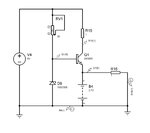JordanElektronika
Junior Member level 2
Good day! I am making a small circuit to power a LOAD through a Battery and power supply. I am making the circuit as simple as possible otherwise I can do it with a PIC microcontroller.
I have: Li-On battery at 3.7V to be charged with 1 to 2A. The load will drain 1 to 2A also. Through the battery I power a LOAD. Through the POWER SOURCE I power the BATTERY.
These few points bother me:
1. Will this circuit really work despite that it looks like it should?
2. Given the 1Ohm resistor will this have any effect at all given that when we make the PCB board the traces will have some resistance or the cables if we solder it manually and will that resistance be 1Ohm also? If the resistance of the Traces is 1Ohm the current should drop in half?
3. If I connect a phone to the batter of the circuit will the phone get charged or discharged?
4. I am using a Zener to keep the voltage at 4.3V. Is that good if we do not know the type of battery that will be used for the circuit and the type of LOAD connected (might be a cell phone) is 4.3V enough? I think I should remove the Zener because the battery will get overcharged or should I leave it to get charged to 4.3V?
5. What is the maximum to which I should consider the battery being discharged - maybe 3V?
6. I have left a diode if the battery drains a too high current the diode will burn and it also prevents the current from the battery to go in the wrong direction?

I have: Li-On battery at 3.7V to be charged with 1 to 2A. The load will drain 1 to 2A also. Through the battery I power a LOAD. Through the POWER SOURCE I power the BATTERY.
These few points bother me:
1. Will this circuit really work despite that it looks like it should?
2. Given the 1Ohm resistor will this have any effect at all given that when we make the PCB board the traces will have some resistance or the cables if we solder it manually and will that resistance be 1Ohm also? If the resistance of the Traces is 1Ohm the current should drop in half?
3. If I connect a phone to the batter of the circuit will the phone get charged or discharged?
4. I am using a Zener to keep the voltage at 4.3V. Is that good if we do not know the type of battery that will be used for the circuit and the type of LOAD connected (might be a cell phone) is 4.3V enough? I think I should remove the Zener because the battery will get overcharged or should I leave it to get charged to 4.3V?
5. What is the maximum to which I should consider the battery being discharged - maybe 3V?
6. I have left a diode if the battery drains a too high current the diode will burn and it also prevents the current from the battery to go in the wrong direction?


